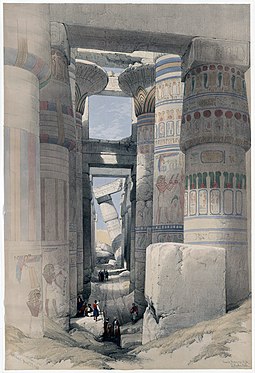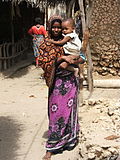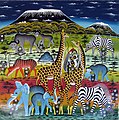Portal:Africa



Africa is the world's second-largest and second-most populous continent after Asia. At about 30.3 million km2 (11.7 million square miles) including adjacent islands, it covers 20% of Earth's land area and 6% of its total surface area. With nearly 1.4 billion people as of 2021, it accounts for about 18% of the world's human population. Africa's population is the youngest among all the continents; the median age in 2012 was 19.7, when the worldwide median age was 30.4. Based on 2024 projections, Africa's population will exceed 3.8 billion people by 2100. Africa is the least wealthy inhabited continent per capita and second-least wealthy by total wealth, ahead of Oceania. Scholars have attributed this to different factors including geography, climate, corruption, colonialism, the Cold War, and neocolonialism. Despite this low concentration of wealth, recent economic expansion and a large and young population make Africa an important economic market in the broader global context, and Africa has a large quantity of natural resources.
Africa is highly biodiverse; it is the continent with the largest number of megafauna species, as it was least affected by the extinction of the Pleistocene megafauna. However, Africa is also heavily affected by a wide range of environmental issues, including desertification, deforestation, water scarcity, and pollution. These entrenched environmental concerns are expected to worsen as climate change impacts Africa. The UN Intergovernmental Panel on Climate Change has identified Africa as the continent most vulnerable to climate change.
The history of Africa is long, complex, and varied, and has often been under-appreciated by the global historical community. In African societies the oral word is revered, and they have generally recorded their history via oral tradition, which has led anthropologists to term them "oral civilisations", contrasted with "literate civilisations" which pride the written word. African culture is rich and diverse both within and between the continent's regions, encompassing art, cuisine, music and dance, religion, and dress.
Africa, particularly Eastern Africa, is widely accepted to be the place of origin of humans and the Hominidae clade, also known as the great apes. The earliest hominids and their ancestors have been dated to around 7 million years ago, and Homo sapiens (modern human) are believed to have originated in Africa 350,000 to 260,000 years ago. In the 4th and 3rd millennia BCE Ancient Egypt, Kerma, Punt, and the Tichitt Tradition emerged in North, East and West Africa, while from 3000 BCE to 500 CE the Bantu expansion swept from modern-day Cameroon through Central, East, and Southern Africa, displacing or absorbing groups such as the Khoisan and Pygmies. Some African empires include Wagadu, Mali, Songhai, Sokoto, Ife, Benin, Asante, the Fatimids, Almoravids, Almohads, Ayyubids, Mamluks, Kongo, Mwene Muji, Luba, Lunda, Kitara, Aksum, Ethiopia, Adal, Ajuran, Kilwa, Sakalava, Imerina, Maravi, Mutapa, Rozvi, Mthwakazi, and Zulu. Despite the predominance of states, many societies were heterarchical and stateless. Slave trades created various diasporas, especially in the Americas. From the late 19th century to early 20th century, driven by the Second Industrial Revolution, most of Africa was rapidly conquered and colonised by European nations, save for Ethiopia and Liberia. European rule had significant impacts on Africa's societies, and colonies were maintained for the purpose of economic exploitation and extraction of natural resources. Most present states emerged from a process of decolonisation following World War II, and established the Organisation of African Unity in 1963, the predecessor to the African Union. The nascent countries decided to keep their colonial borders, with traditional power structures used in governance to varying degrees. (Full article...)
Selected article –

The Niger women's national football team represents Niger in international women's football. It is governed by the Nigerien Football Federation. It has played in four FIFA-recognised matches, two of which were losses to Burkina Faso women's national football team in 2007. There is an under-20 women's national team who were supposed to participate in the 2002 African Women U-19 Championship but withdrew before playing a game. Some problems impact the development of the women's game in Africa that effect Niger of which sexism, abuse, homophobia, religion and financial setbacks have been huge factors. (Full article...)
Featured pictures –
Did you know (auto-generated) -

- ... that a former member of the French Senate ended up being exiled to the northern Central African Republic by the future emperor?
- ... that after the 1999 Tempe military base shooting, the Pan African Congress demanded a military funeral for the perpetrator?
- ... that a former French secret-service agent was responsible for seven out of the 26 Formula One drivers qualifying for the 1980 South African Grand Prix being French?
- ... that Malaysian businessman Lim Kok Wing was depicted as "King of Africa"?
- ... that American Olympic rugby player Sarah Levy is the great-granddaughter of a Springbok?
- ... that the Enterprise, a black newspaper in Omaha, supported a separate African American department at the 1898 Trans-Mississippi Exposition?
Categories
Selected biography –
Francis Piol Bol Bok (born February 1979), a Dinka tribesman and citizen of South Sudan, was a slave for ten years and later became an abolitionist and author living in the United States. (Full article...)
Selected country –
 |
 |
|

| ||
Tunisia (Arabic: تونس Tūnis), officially the Tunisian Republic (الجمهورية التونسية), is a country situated on the Mediterranean coast of North Africa. It is the northernmost African country and the smallest of the nations situated along the Atlas Mountains. Around forty percent of the country is composed of the Sahara desert, with much of the remainder consisting of particularly fertile soil, and a 1300 km coastline.
Tunisia is a republic with a strong presidential system dominated by a single political party. President Zine El Abidine Ben Ali has been in office since 1987, the year he deposed Habib Bourguiba in a bloodless coup. The ruling party, the Democratic Constitutional Rally (RCD), was the sole legal party for 25 years, known previously as the Socialist Destourian Party (PSD). The RCD still dominates political life.
The majority (98%) of modern Tunisians are Arab, and are speakers of Tunisian Arabic. There is also a small population of Berbers, located in the Jabal Dahar mountains and on the island of Jerba, and Jews. (Read more...)
Selected city –
Algiers (/ælˈdʒɪərz/ al-JEERZ; Arabic: الجزائر, romanized: al-Jazāʾir) is the capital city of Algeria as well as the capital of the Algiers Province; it extends over many communes without having its own separate governing body. With 2,988,145 residents in 2008 and over 4,510,000 in 2020 in an area of 1,190 square kilometres (460 sq mi), Algiers is the largest city in Algeria, the third largest city on the Mediterranean, sixth in the Arab World, and 11th in Africa. Located in the north-central portion of the country, it extends along the Bay of Algiers surrounded by the Mitidja Plain and major mountain ranges. Its favorable location made it the center of Ottoman and French cultural, political, and architectural influences for the region, shaping it to be the diverse metropolis it is today.
Algiers was formally founded in 972 AD by Buluggin ibn Ziri, though its history goes back to around 1200-250 BC when it was a small settlement of phoenicians that practiced trade. It was caught under control of many nations and empires such as Numidia, the Roman Empire and the Islamic caliphates, as it went on to become the capital of the Regency of Algiers from 1516 to 1830 AD, then under the control of France due to an invasion that ranked Algiers as capital of French Algeria from 1830 to 1942 AD which temporarily merged with Free France from 1942 to 1944 AD, then back again to French Algeria from 1944 to 1962 AD, and finally capital of Algeria from 1962 to present day after the Algerian Revolution. (Full article...)
In the news
- 5 April 2025 – Somali Civil War
- Colonel Nur Farey, the senior Somali military commander of the 14th brigade, is assassinated by a man believed to be an al-Shabaab militant in Addow Dibille near Afgoye, Lower Shabelle, Somalia. (Hiiraan Online)
- 5 April 2025 – South Sudan–United States relations, Immigration policy of the second Donald Trump administration
- U.S. Secretary of State Marco Rubio announces the revocation of all visas of South Sudanese passport holders, citing "the failure of South Sudan's transitional government to accept the return of its repatriated citizens in a timely manner." (BBC)
- 4 April 2025 – M23 campaign
- The Congolese media reports that M23 rebels retreating from Walikale have arrived in Kibua in North Kivu, Democratic Republic of the Congo. (Critical Threats)
- 4 April 2025 – Democratic Republic of the Congo–United States relations
- Lamuka opposition coalition spokesperson Prince Epenge criticizes the proposed minerals-for-security deal between the Democratic Republic of Congo and the United States, describing it as a "sell-off." (Critical Threats)
- 4 April 2025 –
- Thousands of people demonstrate in Bangui, Central African Republic, to protest against President Faustin-Archange Touadéra's plans to run for a third term with the backing of the Russian-led Wagner Group, who has killed indiscriminately in the country. (AP)
- 3 April 2025 – M23 campaign
- M23 spokesperson Lawrence Kanyuka claims that the group's withdrawal from Walikale, North Kivu Province, Democratic Republic of the Congo, was to show goodwill for peace negotiations. (Critical Threats)
Updated: 17:05, 6 April 2025
General images -
Africa topics
More did you know –
- ... that Liberia College in the country of Liberia was authorized by the legislature in 1851, but did not start classes until 1863?
- ... that the forced removal of 700,000 people from slums in Zimbabwe in 2005 was called "a crime against humanity" by the UN?
- ... that the supreme god of the southern African Bushmen is Cagn, a trickster who shapeshifts into a praying mantis?
- ... that Bahá'í Faith in Niger began during a period of wide scale growth in the religion across Sub-Saharan Africa near the end of its colonial period?
Related portals
Major Religions in Africa
North Africa
West Africa
Central Africa
East Africa
Southern Africa
Associated Wikimedia
The following Wikimedia Foundation sister projects provide more on this subject:
-
Commons
Free media repository -
Wikibooks
Free textbooks and manuals -
Wikidata
Free knowledge base -
Wikinews
Free-content news -
Wikiquote
Collection of quotations -
Wikisource
Free-content library -
Wikispecies
Directory of species -
Wikiversity
Free learning tools -
Wikivoyage
Free travel guide -
Wiktionary
Dictionary and thesaurus


























































































